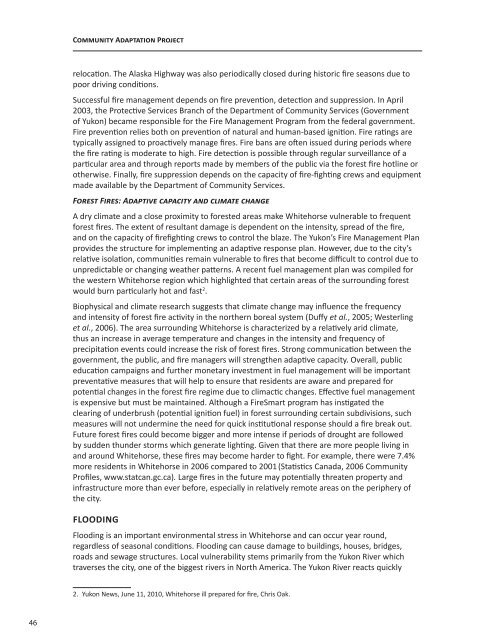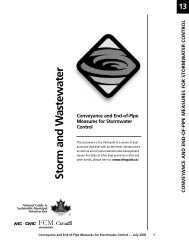Whitehorse Climate Change Adaptation Plan - Yukon College
Whitehorse Climate Change Adaptation Plan - Yukon College
Whitehorse Climate Change Adaptation Plan - Yukon College
You also want an ePaper? Increase the reach of your titles
YUMPU automatically turns print PDFs into web optimized ePapers that Google loves.
46<br />
Community <strong>Adaptation</strong> Project<br />
relocation. The Alaska Highway was also periodically closed during historic fire seasons due to<br />
poor driving conditions.<br />
Successful fire management depends on fire prevention, detection and suppression. In April<br />
2003, the Protective Services Branch of the Department of Community Services (Government<br />
of <strong>Yukon</strong>) became responsible for the Fire Management Program from the federal government.<br />
Fire prevention relies both on prevention of natural and human-based ignition. Fire ratings are<br />
typically assigned to proactively manage fires. Fire bans are often issued during periods where<br />
the fire rating is moderate to high. Fire detection is possible through regular surveillance of a<br />
particular area and through reports made by members of the public via the forest fire hotline or<br />
otherwise. Finally, fire suppression depends on the capacity of fire-fighting crews and equipment<br />
made available by the Department of Community Services.<br />
Forest Fires: Adaptive capacity and climate change<br />
A dry climate and a close proximity to forested areas make <strong>Whitehorse</strong> vulnerable to frequent<br />
forest fires. The extent of resultant damage is dependent on the intensity, spread of the fire,<br />
and on the capacity of firefighting crews to control the blaze. The <strong>Yukon</strong>’s Fire Management <strong>Plan</strong><br />
provides the structure for implementing an adaptive response plan. However, due to the city’s<br />
relative isolation, communities remain vulnerable to fires that become difficult to control due to<br />
unpredictable or changing weather patterns. A recent fuel management plan was compiled for<br />
the western <strong>Whitehorse</strong> region which highlighted that certain areas of the surrounding forest<br />
would burn particularly hot and fast2 .<br />
Biophysical and climate research suggests that climate change may influence the frequency<br />
and intensity of forest fire activity in the northern boreal system (Duffy et al., 2005; Westerling<br />
et al., 2006). The area surrounding <strong>Whitehorse</strong> is characterized by a relatively arid climate,<br />
thus an increase in average temperature and changes in the intensity and frequency of<br />
precipitation events could increase the risk of forest fires. Strong communication between the<br />
government, the public, and fire managers will strengthen adaptive capacity. Overall, public<br />
education campaigns and further monetary investment in fuel management will be important<br />
preventative measures that will help to ensure that residents are aware and prepared for<br />
potential changes in the forest fire regime due to climactic changes. Effective fuel management<br />
is expensive but must be maintained. Although a FireSmart program has instigated the<br />
clearing of underbrush (potential ignition fuel) in forest surrounding certain subdivisions, such<br />
measures will not undermine the need for quick institutional response should a fire break out.<br />
Future forest fires could become bigger and more intense if periods of drought are followed<br />
by sudden thunder storms which generate lighting. Given that there are more people living in<br />
and around <strong>Whitehorse</strong>, these fires may become harder to fight. For example, there were 7.4%<br />
more residents in <strong>Whitehorse</strong> in 2006 compared to 2001 (Statistics Canada, 2006 Community<br />
Profiles, www.statcan.gc.ca). Large fires in the future may potentially threaten property and<br />
infrastructure more than ever before, especially in relatively remote areas on the periphery of<br />
the city.<br />
FLOODING<br />
Flooding is an important environmental stress in <strong>Whitehorse</strong> and can occur year round,<br />
regardless of seasonal conditions. Flooding can cause damage to buildings, houses, bridges,<br />
roads and sewage structures. Local vulnerability stems primarily from the <strong>Yukon</strong> River which<br />
traverses the city, one of the biggest rivers in North America. The <strong>Yukon</strong> River reacts quickly<br />
2. <strong>Yukon</strong> News, June 11, 2010, <strong>Whitehorse</strong> ill prepared for fire, Chris Oak.

















